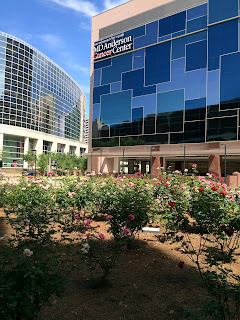Read on down to learn how to enter to win $200 in prizes!
Leaving a legacy. We all want to be remembered fondly for something after we die. We even have songs about leaving a
legacy like the Nichole Noreman's Legacy Nichole Nordeman-Legacy lyrics - YouTube Most people are forgotten after 4 or 5 generations. How many of us can tell something about their great-great- grandmother or grandfather? Monroe Dunaway Anderson broke the odds. He wasn't someone you'd look at and think he's going to go down in history. He wasn't a politician, he wasn't a war hero, but he was a philanthropist.Monroe Dunaway Anderson was born in 1873 the sixth of eight children. He went to Southwestern Baptist University. He and his older brother Frank both worked for their father at the First National Bank of Jackson which he helped establish and became the first president. M.D. as Monroe was called, learned business and finance while working at the bank and went on to several other banks, learning more about the industry.
In 1907 Monroe left banking and moved to Houston, Texas to find bigger banks. He became the Chief Financial Officer and eventually treasurer as well. The company grew and prospered and became the world's largest cotton merchant. They were known as the Cotton King for a century. M.D. was a a great businessman and became a wealthy man.
The company still prospered into the 1930's. Will Clayton and M.D. Anderson owned over half of the company's stock. The problem arose that should either man die that they would owe so much in large estate taxes that they would possibly have to liquidate their company to pay for the taxes.
In 1936 M.D. established the M.D. Anderson foundation and donated $300,000 to the charitable organization. Although there was no stipulations on how the funds must be spent, the trustees were inclined to support health care. Within 2 years of Anderson starting this foundation, he had a stroke while eating lunch with some business associates. While in the hospital they discovered he also had kidney problems. Within a year, M.D. Anderson died and M.D. Anderson Foundation received $19,000,000.
In 1937 cancer was the second leading cause of death in the United States. The numbers couldn't be ignored and in 1940 Texas Medical Association's cancer committee began working with the Texas Health Department to come up with legislation to start attacking this number two killer.The Texas Legislature authorized The University of Texas to build a hospital for treating cancer and for the research of cancer, in 1941. The trustees of M.D. Anderson learned of new endeavor and the $500,000 that was allocated to the research hospital. MDA contacted them and agreed to match the $500,000 with the stipulation that the hospital would be built in Houston and named after M.D. Anderson.
Ready to start, the foundation acquired The Oaks and was able to make it work for what they needed until a permanent hospital was built. There were several buildings on the six acres which allowed room for growth.
A stable and a carriage house were repurposed into laboratories where four doctors were able to start their research. The late forties add several war-surplus buildings to the cancer foundation, increasing its size.
This was done by students with paper at MDA
My husband and I are both patients there and I am amazed by their humble beginnings. To just walk the campus of MD Anderson is an experience. But to interact with the staff and see how the hospital runs is absolutely amazing and so different from other hospitals. It's truly like a well-oiled machine.
To enter to win in the $200 Giveaway click HERE.
Silas Westbrook’s last year at veterinary school ends abruptly when he is called home to care for his young orphaned sisters. Troubles compound when he finds an insurmountable lien on the only home they’ve ever known, and the unscrupulous banker is calling in the loan. The neighbor’s kind-hearted and beautiful stable girl, Krissy, provides the feminine influence the girls desperately need. If only he had a future to offer her. But to save his sisters from poverty, he should set his sights on Krissy’s wealthy relative Kirsten Macleod, the elusive new heiress. Surely this hard-working and unassuming young lady and the landowner could not be one and the same?

.png)










Thank you for sharing. I have a dear friend who has been traveling to MD Anderson, twice a year, for several years now. What a blessing this facility is for people who haven't responded to initial treatment plans!
ReplyDeleteThank you for your post today. I'm so grateful that this place has been available to so many people, you and your husband included. I love hearing about the humble beginnings of truly great institutions.
ReplyDelete